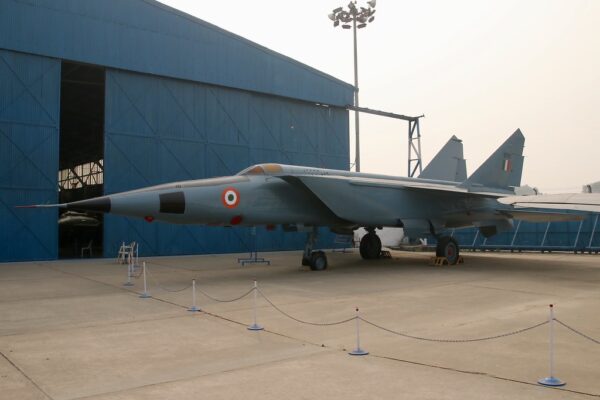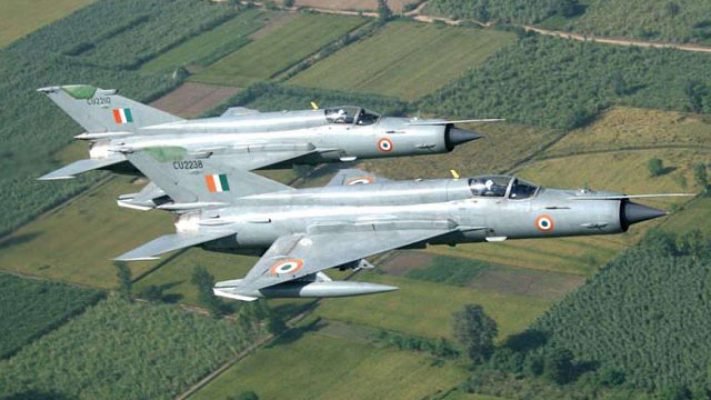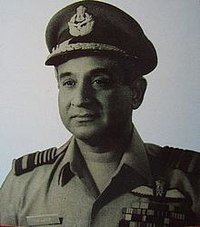
On May 13, an inaccurate blip on the flight tracking website Flightradar24 showed an Indian electronic intelligence (ELINT) gathering aircraft penetrating 100 km deep inside Pakistan and staying within enemy airspace for 10-15 minutes. While there was no official comment from the Indian Air Force (IAF), some open-source intelligence observers in the country went into conspiracy theory mode.
One Twitter handle declared that the “mission” had brutally exposed Pakistan’s air defences. According to this person, the IAF Boeing 707-337 flew over the Shakargarh Bulge with its transponders switched on, stayed in Pakistani airspace for around 10 minutes before switching off its transponders. “It is unusual for an IAF bird to enter the enemy territory with its transponder switched on,” he said.
Flightradar24 quickly tweeted a link to its article that explained how its data is not always correct. For instance, the flight paths of aircraft whose destinations are not known can be off by up to 100 km – uncannily close to how far the Indian Boeing was showing up over Pakistan.
Nevertheless, some media outlets like The Print and the Free Press Journal picked up the tweets and turned them into clickbait articles. However, if the so-called journalists employed by these websites had basic common sense, they should have dismissed the commotion on Twitter with the contempt it deserved. Here are some points to ponder for these Twitter warriors.
1. Indian ELINT aircraft generally loiter 50-200 km away from the border.
2. ELINT aircraft do not have to enter enemy airspace to gather intelligence. Indian electronic eavesdropping aircraft such as the Beriev A-50 Phalcon and Embraer Netra can scoop up data from a distance of between 250 and 375 km. They can loiter in the secure airspace over Delhi or Bareilly and see every single aircraft taking off – or a missile launched – in any part of Pakistan.

3. Why would India risk a relatively slow-moving Boeing by sending it unescorted into an environment where it is vulnerable to anti-aircraft guns and enemy F-16s? What chance does an unarmed and defenceless subsonic aircraft have against enemy fighters? Remember, a MiG-21 that went chasing after and shot down an F-16 was downed in this same air space.
The real spy flights
The highly professional IAF is not known to commit harakiri. It has dedicated aircraft for different missions. One of these was the Russian MiG-25R – the reconnaissance version of the world’s fastest jet fighter ever. This tempestuous jet, codenamed Foxbat by NATO, had a maximum speed of Mach 3.2, or 3,951 kph, a record that has not been beaten after nearly 60 years. However, Foxbat pilots were forbidden to fly over 3,494 kph to avoid engine burnout. Still, it outflew any fighter aircraft ever built. For comparison, Pakistan’s US built F-16 maxes out at 2,414 kph, and the average passenger aircraft has a maximum speed of 988 kph.

For nearly a quarter century, from 1981 to 2006, eight MiG-25s of the Trisonics squadron based in Bareilly, Uttar Pradesh, flew unchallenged over Pakistan (and sometimes Tibet), taking countless high definition photographs and radar images of the situation on the ground. Plus, they recorded electronic emissions from Pakistani and Chinese military communication networks. On an average they flew 10-15 missions a month.
The Pakistani military and political leadership knew about these overflights but kept quiet because they didn’t want to let their people know the Pakistan Air Force was powerless to intercept it. Flying at heights between 65,000 and 85,000 feet and well below its maximum speed, the Indian Foxbats were too high and too fast for the F-16s which also had a lower ceiling of 50,000 feet. At any rate, the F-16’s comfort zone is 35,000 feet.
The Foxbat had no defensive armament but relied on its lightning speed and its high operating ceiling to escape any attacker. It could detect parked aircraft, trains, ships and visualise the condition of bridges and similar structures. The IAF often flew special missions for the Indian Army when it sought intelligence on Pakistani armoured assets. The picture generated by the radar was developed on the ground in a specially equipped van. Former IAF Wing Commander Alok Chauhan told LiveFist: “These aircraft can map a country the size of Pakistan in a single-digit number of missions….”
Demoralising Pakistan
The Pakistani public first came to know of these humiliating overflights in May 1997 when an IAF MiG-25R flew deep into Pakistani airspace on a reconnaissance mission, photographed sensitive defence sites and broke the sound barrier, sending a powerful sonic boom over Islamabad. Before the Pakistanis could figure out what had hit them or scramble their fighter aircraft, the intruding MiG-25 was back in Indian airspace.
Details of the missions are classified, so it remains a mystery why the Indian pilot chose to reveal his presence over a heavily populated area of Pakistan. Some sources like Spyflight, a website dedicated to reconnaissance and surveillance aircraft, have speculated that the MiG-25 pilot wanted to show that the PAF was the IAF’s bunny.
“The aircraft entered Pakistani airspace subsonically (below the speed of sound) at around 65,000 ft and was undetected,” says Spyflight. “Then having overflown and photographed strategic installations near the capital, Islamabad, the aircraft turned back towards India. Perhaps to rub the Pakistanis’ noses in it, the Foxbat pilot decided to accelerate up to Mach 2 and dropped a large sonic boom as he exited Pakistani airspace. A number of PAF F-16As were scrambled, but had insufficient time to make an effective intercept.”
India denied the incident but the then Pakistani Foreign Minister Gohar Ayub Khan believed that the Foxbat photographed strategic installations near Islamabad. Air Power International says the Pakistan government considered the breaking of the sound barrier a deliberate act; to make the point that the PAF had no aircraft in its inventory which could come close to the cruising height of the MiG-25.
Flying at the edge of space, the aircraft was virtually undetectable to Pakistan’s radar network. Only the sonic boom and the fact that it was flying at an unusually low level allowed a Pakistani forward operating base to trace the Foxbat and scramble a couple of F-16As from Sargodha air base.
Chasing the Foxbat was pointless. Sources in the PAF told Air Power International there was no need to intercept an aircraft flying at 65,000 feet as the F-16 could climb to an altitude of only 50,000 feet. If pushed to its limits, the Russian jet could climb much higher. On August 21, 1977, Russian test pilot Alexander Fedotov climbed to an altitude of 123,523 ft – a record that remains unbeaten.
The Foxbat’s speed posed a huge set of problem for any interceptor. It was capable of sustained speeds of Mach 2.5 whereas Western fighters could potentially end up with their engines irreparably damaged if they tried that stunt. The F-16’s normal cruising speed is Mach 1.2 which would allow the MiG-25 to fly laps around it.
The Foxbat’s opponents faced another problem, as the highly experienced and well-equipped Israeli Air Force found out while trying to intercept a Syrian MiG-25. Attacking a Foxbat head on proved unsuccessful because the radars and guidance computers of Western air-to-air missiles couldn’t cope with the MiG’s tremendous closing speed and failed to achieve a lock.
In this backdrop, the smaller and poorly trained PAF had no chance of intercepting the Indian Foxbats which overflew Pakistani territory with impunity.
Till date, the IAF has never divulged details of those missions. The bravehearts who flew these aircraft are long retired and all of them have kept a low profile so far.
How the IAF acquired the Foxbat
The MiG-25 was Russia’s secret weapon against American bombers and therefore was not supplied to even its closest Warsaw Pact allies. However, the defection of the traitor Viktor Belenko in 1976 compromised the aircraft’s secrets and it was made available for export, including to India in August 1981.
Aviation journalist Shiv Aroor of LiveFist quotes former IAF chief Idris Latif: “I was shocked and delighted to learn that the Soviets were actually offering MiG-25 Foxbats to us in 1980. I phoned up Mrs (Indira) Gandhi and she told me to go ahead and make a decision….The Foxbat was the best in the world and it was made available to us.”
Former IAF Chief Idris Latif
Although the photographs taken by the Trisonics remain classified, legendary aviation author Yefim Gordon offers a glimpse into the secretive world of these high-performance jets. In his book ‘MiG-25 Foxbat, MiG-31 Foxhound: Russia’s Defensive Front Line’ Gordon writes: “The MiG-25RB and its versions were popular with their crews due to their exceptional performance: high speed, excellent picture quality, the ability to reconnoitre large areas in a single sortie and low vulnerability to enemy fire.”

Flying into the sunset
With India acquiring high resolution remote sensing satellites with the capability to read even the license plate of a parked army truck, there was no longer a need for reconnaissance aircraft to overfly enemy territory. The MiG-25R began to look like a Cold War relic.
The other reason was the issue of spare parts from Russia. IAF officers report that the Russians had closed down the plants that made Foxbat parts. They had even got rid of the blueprints.
The Trisonics are gone but hopefully one day the IAF will release the stories of its missions that will detail how they ran rings around the Pakistanis.
The author is a New Zealand based defence analyst. His work has been quoted extensively by leading Think Tanks, Universities and Publications world wide. The views expressed are of the author and do not necessarily reflect the views of Raksha Anirveda.








